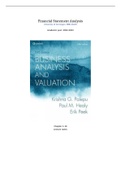Summary
Financial Statement Analysis for A&C summary - Chapter 1-10
- Course
- Institution
- Book
summary for the course Financial Statement Analysis (for A&C). the summary contains chapters 1 through 10, supplemented by notes from the lectures and tutorials. I passed the course with a 9 using this summary.
[Show more]




